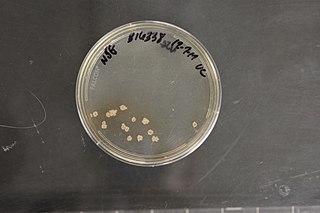Related Research Articles

The Alteromonadales are an order of Pseudomonadota. Although they have been treated as a single family, the Alteromonadaceae, they were divided into eight by Ivanova et al. in 2004. The cells are straight or curved rods. They are motile by the use of a single flagellum. Most of the species are marine.
The Alteromonadaceae are a family of Pseudomonadota. They are now one of several families in the order Alteromonadales, including Alteromonas and its closest relatives. Species of this family are mostly rod-like shaped and motile by using one polar flagellum.
Microbacterium sediminis is a Gram-positive, rod-shaped, aerobic, psychrotolerant, thermotolerant, halotolerant, alkalitolerant bacterium from the genus Microbacterium which has been isolated from deep-sea sediments from the Indian Ocean.
Haloechinothrix alba is a halophilic bacterium from the genus Haloechinothrix which has been isolated from soil from the Qijiaojing Lake in Xinjiang, China.
Aquisalibacillus is a moderately halophilic, rod-shaped and non-motile genus of bacteria from the family of Bacillaceae with one known species.
Yaniella flava is a Gram-negative, aerobic, non-spore-forming and non-motile bacterium from the genus Yaniella which has been isolated from saline soil from the Qinghai Province in China.
Yaniella halotolerans is a Gram-negative, aerobic, halotolerant, non-spore-forming and non-motile bacterium from the genus Yaniella which has been isolated from saline soil from Xijiang, China.
Natranaerobius thermophilus is a thermophilic, obligately anaerobic and halophilic bacterium from the genus of Natranaerobius which has been isolated from the Wadi An Natrun lake in Egypt.
Idiomarinaceae is a Gram-negative and mesophilic family in the order of Alteromonadales. Bacteria of the family Idiomarinaceae occur in saline environments.
Ferrimonadaceae is a family in the order of Alteromonadales.
Terrimonas is a Gram-negative, aerobic and non-motile genus of bacteria from the family of Chitinophagaceae.
Aquisalimonas asiatica is a Gram-negative, moderately halophilic, strictly aerobic and motile bacterium from the genus of Aquisalimonas which has been isolated from water from the Lake Chagannor from the Inner Mongolia.
Aquisalimonas halophila is a Gram-negative, moderately halophilic and strictly aerobic bacterium from the genus of Aquisalimonas which has been isolated from soil from a hypersaline mine from Yunnan in China.
Aquisalimonas lutea is a Gram-negative, moderately halophilic, strictly aerobic and motile bacterium from the genus of Aquisalimonas which has been isolated from water of a saltern from Santa Pola in Spain.

Stackebrandtia is a Gram-positive, aerobic and non-motile genus of bacteria from the family of Glycomycetaceae. Stackebrandtia is named after the German microbiologist Erko Stackebrandt.
Haloglycomyces albus is a Gram-positive, anaerobic and moderately halophilic species of bacteria from the family of Glycomycetaceae.
Jeotgalibacillus campisalis is a Gram-positive, endospore-forming, rod-shaped, moderate halophilic and motile bacterium from the genus of Jeotgalibacillus which has been isolated from a marine solar saltern from Korea.
Flaviramulus is an obligately aerobic and Gram-negative genus of bacteria from the family of Flavobacteriaceae.
Mesonia is a strictly aerobic and chemoorganotrophic genus of bacteria from the family of Flavobacteriaceae.
Halanaerobaculum is a haloanaerobic genus of bacteria from the family of Halobacteroidaceae.
References
- 1 2 3 4 5 6 "Aquisalimonas". LPSN .
- 1 2 "Aquisalimonas". www.uniprot.org.
- ↑ Parker, Charles Thomas; Osier, Nicole Danielle; Garrity, George M (23 April 2009). Parker, Charles Thomas; Garrity, George M (eds.). "Taxonomic Abstract for the genera". NamesforLife, LLC. doi:10.1601/tx.10358.
{{cite journal}}: Cite journal requires|journal=(help) - ↑ Ventosa, Antonio; Oren, Aharon; Ma, Yanhe (2011). Halophiles and Hypersaline Environments: Current Research and Future Trends. Springer Science & Business Media. p. 92. ISBN 9783642201981.
- ↑ Maheshwari, Dinesh K.; Saraf, Meenu (2015). Halophiles: Biodiversity and Sustainable Exploitation. Springer. p. 281. ISBN 9783319145952.
- ↑ Falkiewicz-Dulik, Michalina; Janda, Katarzyna; Wypych, George (2015). Handbook of Material Biodegradation, Biodeterioration, and Biostablization. Elsevier. p. 22. ISBN 9781927885024.